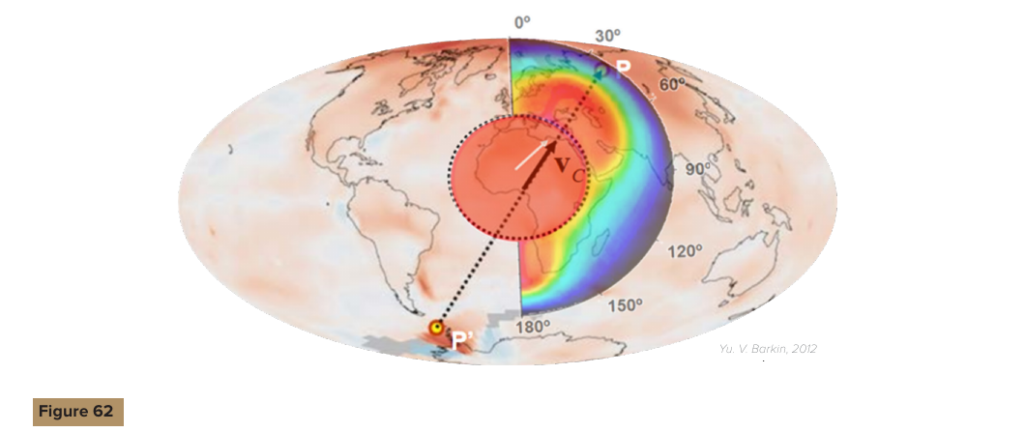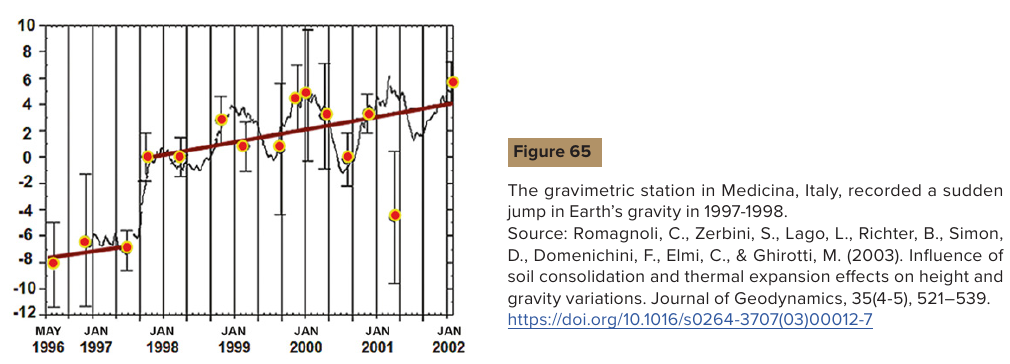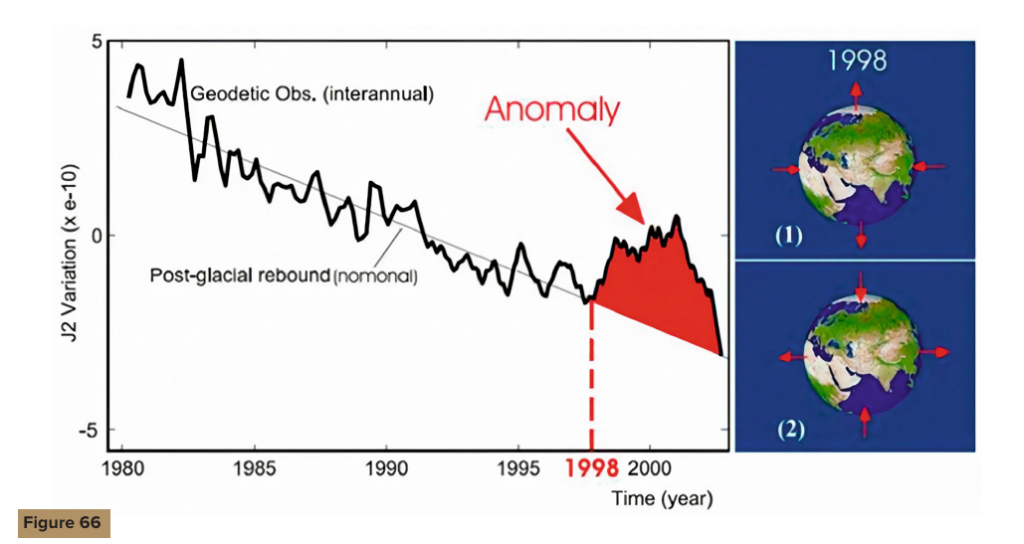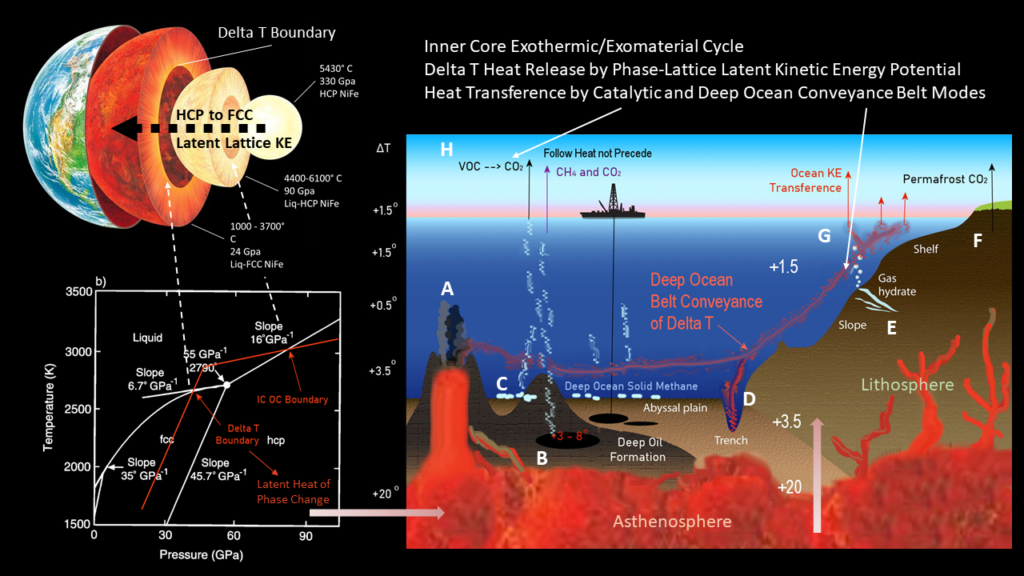Màj 21 octobre 2024 – légendes à traduire
La Creative Society propose comme explication intermédiaire aux phénomènes observés le déplacement du noyau. Ce n’est d’ailleurs pas une proposition théorique à proprement parler puisque, d’après les sources indiquées, ce déplacement aurait été détecté au moment où il a eu lieu, vers 1997-1998.
De son côté, The Ethical Skeptic développe une théorie qui implique une série de transitions de phases des structures cristallines ferriques présentent dans le noyau et le manteau.
Version CS
D’après CS, un déplacement du noyau aurait été mis en évidence vers 1997-1998 (CS-CR p52 à 54).
Remarque : si c’est effectivement le cas, ce point serait plutôt à ranger dans la section Phénomènes observés.
Sources indiquées :
- Barkin, Y. V. (2011). Sinhronnye skachki aktivnosti prirodnyh planetarnyh processov v 1997-1998 gg. i ih edinyj mekhanizm [Synchronous spikes in the activity of natural planetary processes in 1997-1998 and their unified mechanism]. in Geologiya morej i okeanov: Materialy XIX Mezhdunarodnoj nauchnoj konferencii po morskoj geologii [Geology of Seas and Oceans: Materials of the XIX International Scientific Conference on Marine Geology]. Moscow: GEOS, 5, 28-32 (pas de lien web indiqué)
- Zotov, L. V., Barkin, Y. V. & Lyubushin, A. A. (2009). Dvizhenie geocentra i ego geodinamika [The motion of the geocenter and its geodynamics]. In 3rd. conf. Space geodynamics and modeling of global geodynamic processes, Novosibirsk, September 22-26, 2009, Siberian Branch of the Russian Academy of Sciences. (pp. 98-101). Novosibirsk: Geo. (pas de lien web indiqué)
- Cox, C., & Chao, B. F. (2002). Detection of a large-scale mass redistribution in the terrestrial system since 1998. Science, 297(5582), 831–833. https://doi.org/10.1126/science.1072188

Figure 62 : déplacement du noyau survenu en 1997-1998 et vagues thermiques dans le magma causées par ce déplacement.
La carte illustre le vecteur-déplacement du noyau depuis l’Antarctique ouest vers l’ouest de la Sibérie (en direction de la péninsule de Taimyr). Ce schéma est superposé à une carte représentant les anomalies thermiques dans l’atmosphère.
Source: Geophysical implications of relative displacements and oscillations of the Earth’s core and mantle. Presentation by Yu.V. Barkin, Moscow, IFZ, OMTS. September 16, 2014 (pas de lien web).

Figure 63 : Structure interne de la Terre : la direction de la dérive du centre de gravité de la Terre et la trajectoire de son pôle [nord ] sur la surface terrestre sur la période 1990-2010 : on remarque un « virage » de presque 90° en 1997-1998, en direction de la péninsule de Taimyr (Barkin Yu.V., Klige R.K., 2012 – pas de lien web) [ces figures ont été reproduites dans Exposure of the solar system and the earth to external influences. (2018). Physics & Astronomy International Journal, https://doi.org/10.15406/paij.2018.02.00104]

Figure 65 : La station gravimétrique de Medicina (Italie) a enregistré un saut soudain dans l’intensité de l’accélération de la gravité terrestre en 1998-1998.
Source : Influence of soil consolidation and thermal expansion effects on height and gravity variations. (2003) Journal of Geodynamics.
https://doi.org/10.1016/s0264-3707(03)00012-7

Figure 66 : En 1998, les données obtenues par le « laser rangefinder system » DORIS (Doppler Orbitography and Radiopositioning Integrated
by Satellite – France), ont mis en évidence un changement marqué dans la forme de la Terre : son volume a augmenté.8
Source: Detection of a large-scale mass redistribution in the terrestrial system since 1998. (2002). Science.
https://doi.org/10.1126/science.1072188
Version TES
Elle est exposée dans son article Alternative explicative… .
D’après cette thèse, la chaleur provient d’une série de transitions de phases du fer lors d’un transfert depuis le noyau interne (structure HCP « Hexagonale ») vers le noyau externe (état liquide) vers le manteau (structures FCC « cubique à face centrée » et BCC « cubique centrée »). Ce changement d’état est représenté en rouge sur le diagramme de phases en bas à droite de l’illustration ci-après.

À traduire et compléter avec références.
+ explications complémentaires (en quoi le processus du point 1. serait-il discontinu et causerait des phases de « surchauffe » ?)

1. Le noyau terrestre subit des changements exothermiques extrêmes : le fer sous forme hexagonal compact (HCP), à haute énergie latente, se détache de sa couche H et pénètre dans le noyau externe où il se transforme en fer cubique liquide à faces centrées (FCC/BCC)* plus de l’énergie cinétique (chaleur latente de transition de phase). La perméabilité magnétique du noyau s’affaiblit et son dipôle géomagnétique se déplace. La rotation de la Terre s’accélère sur une base décennale en raison de la perte de couplage magnétique entre le noyau externe et le manteau. L’inclinaison axiale de rotation de la Terre change également.
* NDLR : si on se réfère au diagramme de phases représenté sur la figure précédente, le fer passe par l’état liquide dans le noyau externe pour ensuite se cristalliser sous forme FCC/BCC dans le manteau.
2. La chaleur exothermique qui en résulte finit par atteindre l’asthénosphère terrestre. Les poches profondes d’alcanes acycliques bruts sont chauffées et accélèrent la libération de composés organiques fractionnés et volatils dans l’atmosphère. Les taux de méthane dépassent de loin les prévisions des modèles [communément admis]. Les océans, riches en carbone 12, et la toundra, désormais plus chaude, libèrent proportionnellement plus de carbone à chaque réchauffement solaire printanier.
3. Les ceintures de transport océaniques abyssales captent ces afflux de chaleur provenant de zones de petites tailles mais néanmoins à forte contribution et désormais beaucoup plus chaudes car exposés à l’asthénosphère. Elles transportent (non par conduction, ni convection, ni rayonnement) cet apport de chaleur à travers les systèmes d’advection et de remontée d’eau océaniques jusqu’à la surface de l’océan. Les courants océaniques abyssaux (et par conséquent ceux de surface également) s’accélèrent grâce à l’ajout discret d’énergie cinétique. Les calottes glaciaires polaires de l’Arctique et de l’Antarctique fondent rapidement en hiver, de bas en haut. Les terres se dessèchent plus rapidement et les incendies de forêt éclatent plus tôt et hors saison, en particulier à proximité des panaches de chaleur.
4. L’océan réchauffe l’atmosphère (ou ne parvient plus à la refroidir aussi bien qu’auparavant) beaucoup plus facilement que l’atmosphère ne réchauffe l’océan.
Cet équilibre exothermique entre le noyau et le manteau est cyclique et peut s’inverser à terme.

